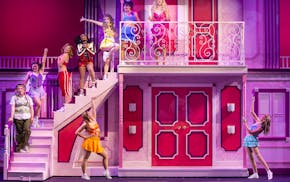What's onboard for development in downtown Minneapolis for 2025?
Not a lot.
The Minneapolis Big Build, the Downtown Council's campaign for the remarkable construction boom of the 2010s and '20s, is done. Or taking a breather.
Renovation and rehabbing isn't as exciting as new tall towers. The kitschy-cool overhaul of the Northstar Center added welcome notes of fun and midcentury swank to the skyway life, but the exterior is still the same drab stolid hunk. If the news says another empty office tower will be turned into housing, it leads to conflicting feelings — it's nice that the site is finding a new purpose but sad no one works there anymore.
To be honest, the idea that nothing much new will happen to downtown Minneapolis this year would provoke shrugs from most who live in the metro. The idea that downtown St. Paul might be likewise unmolested by construction and innovation will draw a similar reaction.
Most people outside of the core regard the downtowns in the Twin Cities as a place to catch a meal and a show once or twice a year. But what they really think of these downtowns is something different. To them, the downtowns are destinations where you need to pay to park, and maybe watch your back. But they are not places where you go to shop or watch a movie.
These people tend to come downtown only if there's something there they can't get elsewhere. Or if they feel as if they absolutely have to experience it on a regular basis.
Hence the Minneapolis Community Planning & Economic Development Department blueprint for the future of downtown, the Downtown Action Plan. It's a cheerful and optimistic proposal, repositioning downtown from its pre-pandemic days into "the place for fun, culture and entertainment, with a wide array of restaurants, nightclubs, live music and sporting events. Downtown Minneapolis is the only destination for local, national and international visitors looking for a premier experience."
A noble goal. We would all be proud if Minneapolis was the toast of the international travel circuit, and we'd all be delighted if downtown was not just a place, but the place.
One of the Action Plan's objectives is the return of first-floor retail.
"Focus on first floor and storefront activation by leveraging and expanding existing grants, loan programs and financial incentives to improve effectiveness downtown," it says. Let's translate that: "after half a century of demolishing small-scale buildings that provided spaces for niche retail, and replacing them with towers that prioritized skyway retail to capitalize on year-round captive audience foot traffic, we hope to scare up some cash to retrofit some buildings, so they might have ground-floor retail, maybe?"
It's a good idea, but if the demand was there, skyway retail would be robust and diverse. The ground-floor retail model is a holdover from the days before the malls slayed downtown shopping, and we would all love to see it come back.
Another idea is to make Nicollet Mall all pedestrian. The plan also includes more interesting alleys with shops and kiosks.
We agree to them, but these are not big dreams. So, let us cast our imaginations 10 years forward, and dream what downtown Minneapolis might be like in 2035, if there were no practical obstructions.
The city should declare "we absolutely had no idea what we were doing with the Nicollet Mall renovation, and we apologize for the sterile, clammy, underwhelming design. We're going to fill it with trees and fountains and planters and benches, and add interesting neon and other forms of signage and displays that delight the eye." Downtown Minneapolis will become a destination for dining and shopping, thanks to the repeal of the stadium tax and the dollar-an-hour parking fee in ramps after 5 p.m.
The Martin Olav Sabo Post Office celebrates its third year as an entertainment hub, with nightclubs, bars and cafes. The expansive rooftop complex has a commanding view of the river — including the revitalized retail complex of Riverplace and St. Anthony Main — and weekend sunset fireworks draw appreciative crowds. The Cross-Mississippi zip-line from the post office to the East Bank is a popular attraction, too.
The IDS Center opens its observatory on the top floor for the first time in decades, including an elevator ride modeled after the World Trade Center in New York, where one learns of the history of downtown and its rise on video screens as the car ascends.
The Ameriprise building, rumored in 2024 to be an economic albatross whose vacancy rate might necessitate demolition, has become a sports complex, with 20 floors given over to go-kart racing, 10 floors devoted to the world's tallest climbing wall and a bungie-jump that lets people plunge the height of the 37-story structure.
Personal Autonomous Cabs, aka PAC-Mans, whiz people around downtown from bar to restaurant to theater to other amusements in self-driving pods. These are particularly welcome in the winter, when even downtown residents blanch at leaving the house on a bitter night.
Hennepin and 7th Street are ablaze nightly with the Midwest's largest assemblage of electronic billboards, a display that rivals New York's Times Square. Traffic at the intersection was rerouted underground in 2031, creating a public plaza where people can mill about and drink and nosh on food sold by street corner carts and vendors from adjacent storefronts.
They are all doable but that's unlikely to happen.
People used to go downtown because there weren't many good alternatives. Now they go downtown because it's an alternative to sticking close to home. It can be better, and we can hope that it will be. We needn't shoot for a Times Square-style attraction with international reputation. We just need to get to the point where someone can say "Let's go downtown," and no one need ask "But why?"

For 'Legally Blonde' star, 'being underestimated is her secret superpower'

Restaurant openings and closings in the Twin Cities

Minnesota's Amy Thielen launches old-fashioned radio show for food lovers
Yuen: How success has pushed Minnesotans off sidelines in trans athlete debate

